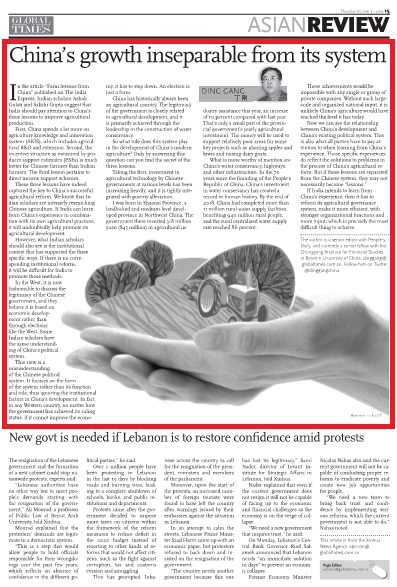Global Governance
Your Present Location: PROGRAMS> Global GovernanceDing Gang: China’s growth inseparable from its system
By Ding Gang Source: Global Times Published: 2019-10-31
In the article "Farm lessons from China" published on The India Express, Indian scholars Ashok Gulati and Sakshi Gupta suggest that India should pay attention to China's three lessons to improve agricultural production.

First, China spends a lot more on agriculture knowledge and innovation system (AKIS), which includes agricultural R&D and extension. Second, the incentive structure as measured by producer support estimates (PSEs) is much better for Chinese farmers than Indian farmers. The third lesson pertains to direct income support schemes.
These three lessons have indeed captured the key to China's successful agricultural reform. We know that Indian scholars are intensely researching Chinese agriculture. If India can learn from China's experience in combination with its own agricultural practices, it will undoubtedly help promote its agricultural development.
However, what Indian scholars should also see is the institutional context that has supported the three specific ways. If there is no corresponding institutional reform, it will be difficult for India to promote those methods.
In the West, it is now fashionable to discuss the legitimacy of the Chinese government, and they believe it is based on economic development rather than through elections like the West. Some Indian scholars have the same understanding of China's political system.
This view is a misunderstanding of the Chinese political system. It focuses on the form of the system rather than its function and role, thus ignoring the institutional factors in China's development. In fact, in any Western country, no matter how the government has achieved its ruling status, if it cannot improve the economy, it has to step down. An election is just a form.
China has historically always been an agricultural country. The legitimacy of the government is closely related to agricultural development, and it is primarily achieved through the leadership in the construction of water conservancy.
So what role does this system play in the development of China's modern agriculture? Only by answering this question can you find the secret of the three lessons.
Taking the first, investment in agricultural technology by Chinese governments at various levels has been increasing heavily, and it is tightly integrated with poverty alleviation.
I was born in Shaanxi Province, a landlocked and medium-level developed province in Northwest China. The government there invested 318 million yuan ($45 million) in agricultural industry assistance this year, an increase of 10 percent compared with last year. That's only a small part of the provincial government's yearly agricultural investment. The money will be used to support relatively poor areas for some key projects such as planting apples and kiwis and raising dairy goats.
What is more worthy of mention are China's water conservancy, highways, and other infrastructure. In the 70 years since the founding of the People's Republic of China, China's investment in water conservancy has created a record in human history. By the end of 2018, China had completed more than 11 million rural water supply facilities, benefiting 940 million rural people, and the rural centralized water supply rate reached 86 percent.
These achievements would be impossible with any single or group of private companies. Without such large-scale and organized national input, it is unlikely China's agriculture would have reached the level it has today.
Now we can see the relationship between China's development and China's existing political system. This is also what all parties have to pay attention to when learning from China's experience. Those specific experiences do reflect the solutions to problems in the process of China's agricultural reform. But if these lessons are separated from the Chinese system, they may not necessarily become "lessons."
If India intends to learn from China's experience, then it has to reform its agricultural governance system, make it more efficient, with stronger organizational functions and more input, which is precisely the most difficult thing to achieve.
The author is a senior editor with People's Daily, and currently a senior fellow with the Chongyang Institute for Financial Studies at Renmin University of China.























































































 京公网安备 11010802037854号
京公网安备 11010802037854号





